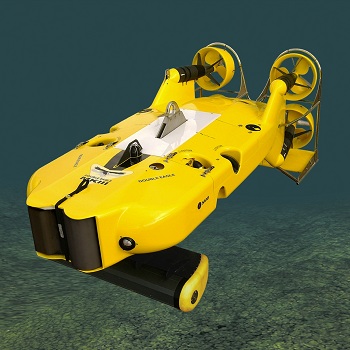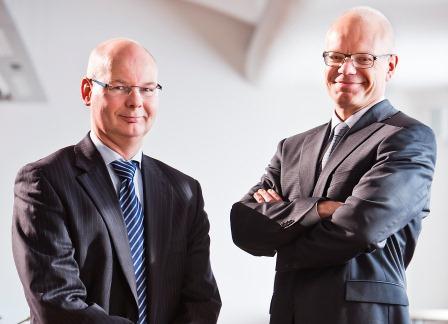The EDA has developed an innovative, flexible way to manage complex, long-term defence research, reports Philip Butterworth-Hayes in the third issue of the Agency’s European Defence Matters magazine.
It is one of the biggest challenges facing defence organizations around the world: how can you flexibly manage a vital, strategic military research programme encompassing a host of related but independent technologies – from initial academic research to developing a systems platform – over a long period, when economic conditions and threat environments change? When this challenge is spread across a whole continent the institutional and economic issues become even more complex.
 This has been the challenge that EDA has faced with its €53.7 million Unmanned Maritime Systems (UMS) programme, which aims to deliver advanced maritime mine counter-measures and related technologies in the second half of this decade (see also European Defence Matters, issue one). Its solution has been to develop a flexible, integrated research programme within the research and technology (R&T) Directorate of the Agency, with 14 different projects and encompassing a total of 11 participating Member States (pMS), each with different areas of interest. In parallel, pMSs have launched Maritime Mine Counter Measures (MMCM) work in the Armaments Directorate which aims at the common development and procurement of MMCM assets in the shorter term.
This has been the challenge that EDA has faced with its €53.7 million Unmanned Maritime Systems (UMS) programme, which aims to deliver advanced maritime mine counter-measures and related technologies in the second half of this decade (see also European Defence Matters, issue one). Its solution has been to develop a flexible, integrated research programme within the research and technology (R&T) Directorate of the Agency, with 14 different projects and encompassing a total of 11 participating Member States (pMS), each with different areas of interest. In parallel, pMSs have launched Maritime Mine Counter Measures (MMCM) work in the Armaments Directorate which aims at the common development and procurement of MMCM assets in the shorter term.
Maritime Mine Counter Measures a Capability Priority
From the outset the MMCM work strand has been a ‘live’ exercise, expanding and developing to meet the needs of the participants. “It was initiated within the Capability Directorate in 2008, as MMCM was identified as one of the 12 capability priorities. The idea was to bring nations together to develop further a Common Staff Target already developed at an earlier stage and to prepare for the replacement of MMCM capabilities currently in service in EU nations,” said Bart Stoelinga, Senior Officer For Maritime Programmes. “When the concept was further developed it became obvious we were looking at a stand-off, unmanned solution. We had a number of discussions in the Agency and among pMSs and from the broad idea of an unmanned, standoff concept a number of projects were identified that would need a technical solution by 2018. The UMS programme was started to work on these different areas.”
Ministers approved the UMS programme as an R&T programme in 2009, but it has evolved considerably over the years. New work strands have been added and others were redefined; this year will see the start of a new work strand on the use of fuel cells in unmanned underwater vehicles while other elements of the work are being extended. “It’s a living programme,” said Jari Hartikainen, Technology Manager R&T Directorate. "Different smaller projects can be introduced by Member States into the wider programme framework to meet their own national interests. This supports specialisation, so small countries can participate in work which reflects their own expertise and it also means these countries, with relatively small budgets, can acquire a great deal of knowledge in this important area of research.”
The aim is to develop technologies, within the R&T programme, which can be carried forward into an Armaments Directorate development project. By closely linking the detailed R&T work with the strategic Capability Development Plan (CDP), which is being constantly updated, the idea is to minimize waste in resources from duplicated research. The CDP gives direction to the work carried out in the programme. The Capability Directorate has carried out a landscaping study on future naval requirements to highlight (future) capability gaps and the R&T Directorate has organised a number of workshops on the strategic research agenda to identify critical areas where work needs to be carried out. Meanwhile, the Industry and Market Directorate has commissioned a study of key industrial capabilities in the naval domain. Reliance on civilian R&T developments is a growing trend and in research areas such as batteries, navies invest only in defence specific R&T as this is a generic technology with relevant work being undertaken elsewhere. “We also organised a joint workshop with the European Commission in May 2012 to compare what we are both doing and to see how defence and civilian R&T can support each other,” said Jari Hartikainen. “Key technology challenges, such as autonomous operation, underwater communications, sensors and efficient power systems are common to both military and civilian systems.”
Identifying Opportunities for Collaboration in Research
 The work in the UMS programme spans also more general issues, such as systems integration, standardization, safety and regulations. “Unmanned systems are not recognized in international shipping rules,” said Jari Hartikainen, “which is a major obstacle against their widespread use.” Standardization is also an absolute prerequisite for more affordable and more interoperable systems.
The work in the UMS programme spans also more general issues, such as systems integration, standardization, safety and regulations. “Unmanned systems are not recognized in international shipping rules,” said Jari Hartikainen, “which is a major obstacle against their widespread use.” Standardization is also an absolute prerequisite for more affordable and more interoperable systems.
Participants in the UMS programme include defence organizations, industry and research institutes. “Studies which require specific scientific or industrial expertise are sometimes launched by EDA on behalf of the member states” said Bart Stoelinga. “So it’s not just about technology push. The framework of UMS allows countries to identify opportunities for collaboration in research, which will feed in to their national programmes. Some defence industries may bring technologies that they have developed trying to find solutions to problems in the air and land environment for use in the naval environment. We can capitalise on this.”
One of the other major challenges is institutional: trying to find ways to align the budgets of different nations so common funding streams to agreed timelines can be developed, making best use of the collaborative process. Despite the challenges, the flexible, integrated structure of the UMS programme has worked well and EDA is in the first stages of exploring whether a similar structure could be used for research in other areas like mission modular naval ships or unmanned aerial systems.
UMS programme facts
There are 11 contributing Members funding the UMS programme: Belgium, Finland, France, Germany, Italy, the Netherlands, Norway, Poland, Portugal, Spain and Sweden. Of the €53.7 million budget, the industrial contribution is €6.7 million. The key UMS project areas are listed below:
- Robust acoustic communications for underwater networks
- Harbour and base protection systems
- Systems integration
- Standards and interfaces for more interoperable European unmanned maritime systems
- Safety and regulations for European unmanned maritime systems
- Conformal array performance estimation modeling
- Modular lightweight minesweeping
- Signature response analysis of multi-influence mines
- Network enabled cooperation system of autonomous vehicles
- Increased autonomy of AUVs – mission planning and obstacle avoidance
- Buried mines
- Evaluation of thin line array technologies
- Submarine coupled 6dof motions, including boundary effects
- Drifting mines detection
More information: